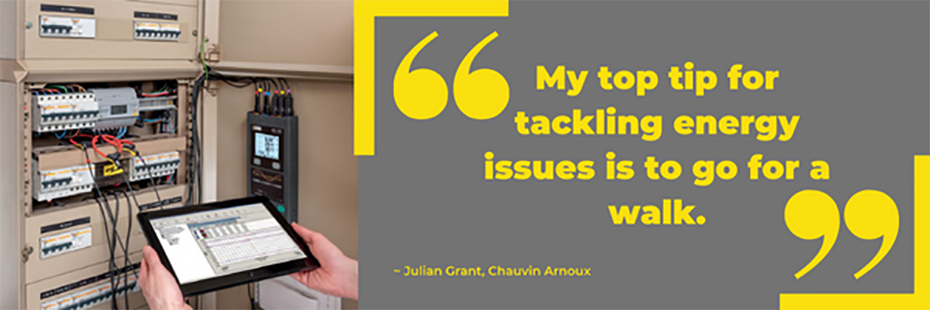
General manager of Chauvin Arnoux UK, Julian Grant, sat down with Energy Manager Magazine (EM Magazine) to discuss his top tips for saving energy. A convergence of environmental and energy crises combined with changing working habits has put additional pressure on facilities managers to find savings and limit emissions. Therefore, it came as a bit of a surprise when Julian Grant, a man who according to his LinkedIn profile has over thirty-eight years of experience in electrical test and measurement equipment with a particular focus on energy efficiency, advocated taking a walk and watching your electricity usage as ways to reduce consumption and expenditure! Was this really the best advice he had to offer struggling facilities managers?! Well, like all things energy, the value of Julian Grant’s comments only becomes apparent after further investigation.
Quick Links
- Post-Pandemic Challenges Facing Facilities Managers
- Walking & Watching: Julian Grant’s Top Tips for Saving Energy
- Further Information
Post-Pandemic Challenges Facing Facilities Managers

The COVID-19 pandemic drastically altered our lives. Most adjustments made during various lockdowns have slowly eroded; however, one is clearly here to stay: hybrid working. Changes in the way we use office space and appliances inevitably mean a change in companies’ energy consumption. It is down to facilities managers to optimise this post-pandemic energy usage. Yet another challenge they can add to new worries brought on by the cost-of-living crisis, as well as pre-existing concerns about ensuring sustainability and meeting net-zero targets.
Data published in the December/ January 2023 edition of FMJ states that 39% of global carbon emissions can be attributed to buildings, with 28% of these emissions resulting from operational activities, powering, heating, and cooling.[1] The article explains that a 2021 survey conducted by the Institute of Workplace and Facilities Management found that the key priority for 70% of respondents was to reduce the carbon footprint and emissions of the buildings under their jurisdiction. It is also revealed that of this 70%, 62% felt that they did not have access to the necessary data required to make meaningful changes. [2]
Walking & Watching: Julian Grant’s Top Tips for Saving Energy

In the face of these anxieties, suggestions like adding extra insulation or changing to LED bulbs seem flippant, and guidance such as taking a walk comes across as plain ridiculous! Yet, taking a walk is exactly what Julian Grant recommends:
“Actually, my top tip for tackling energy issues is to go for a walk [...] go for a walk around your building out of hours – in the evening after everyone has gone home and at the weekend when the building is closed. How many lights have been left on? How many machines or items of office equipment are still running? You may have quite a surprise – unnecessary out-of-hours usage is still one of the most significant ways organisations waste energy. Usually it’s pretty easy to fix – time switches are very inexpensive!”[3]
A British Gas survey of 6000 smart meters belonging to small/medium enterprises (SMEs) found that 46% of electricity consumption occurred outside of business hours. This electricity usage can be attributed to leaving lighting, heating, and IT equipment on 24/7. Chauvin Arnoux estimates that just leaving office equipment on standby over bank holidays and weekends costs the average SME £6000 a year; and calculates that switching non-essential equipment off at the end of the day could produce a 12% saving on energy bills.[4] In this context, Julian Grant’s advice doesn’t seem so outrageous. Walking around your building after hours is a simple, quick, and free method of identifying areas where significant energy savings may be made.
Mr Grant also advocates that facilities managers don’t dismiss pointers such as switching to LED lights and installing more insulation - however tired they are of hearing them. Chauvin Arnoux's article, The Importance of Metering and Monitoring Energy Consumption, states that heat loss due to poor or missing pipe lagging accounts for a 50% reduction in the efficiency of many industrial installations, while offices can lose up to 60% of their heat through the fabric of their buildings.[5] Therefore ensuring proper insulation could significantly reduce energy bills. Furthermore, Chauvin Arnoux note in the white paper, Sound Advice on Saving Energy: Outlining the Path to Sustainability and Energy Efficiency, that switching from incandescent light bulbs to LED ones could offer a potential saving of up to 80%.[6]
Access Chauvin Arnoux’s White Paper Here
Challenged by EM Magazine's interviewer on whether there is a more time-efficient way of monitoring energy usage that doesn’t involve coming into work after hours, Julian Grant explains:
“You can hook up a PEL to any circuit in your building and leave it in place to record energy usage – and a lot more information – even when you’re not there. Actually, it will tell you much more than just which lights or which machines have been left on unnecessarily. It will tell you exactly where energy is being used in your organisation and when as well as providing information about things like harmonics, voltage imbalance and poor power factor that could be costing you a lot of money. Armed with this information, you’ll know exactly where savings are most likely to be possible.”[7]
Using a portable energy logger, such as a Chauvin Arnoux’s PEL, to watch your energy usage means you can take targeted action to correct energy-inefficient equipment or plug energy leaks. The Carbon Trust estimates that by installing energy efficiency measures, including, but not limited to, variable-speed drives for fans, pumps, and other motor-driven systems, businesses can expect to make energy savings of up to 20%.[8]
Julian Grant goes on to stress that monitoring your energy usage is not an as-and-when activity. Facilities managers must integrate PELs into their maintenance routines, repeating inspections at regular intervals throughout the year to account for the following:
- Seasonal changes in energy use: for example, problems that are not apparent in a summer survey may present themselves during a winter one
- Addition of new equipment: integrating new equipment into a system could cause an unbalanced load on a three-phase system, or may significantly increase harmonics, adversely affecting the power factor
- Removal of old equipment: disconnecting old equipment can also result in an unbalanced load
- Equipment damage: defective equipment may produce more harmonics, producing a negative effect on the power factor
- Fluctuating energy prices: ever-increasing energy prices could mean that efficiency measures that were unprofitable in the previous quarter may offer significant savings in the current one.[9]
Mr Grant concludes his interview with EM Magazine by stressing
“These are not do-it-once and-forget tasks. Regular attention is the best way to relieve the pain of huge energy bills while doing your organisation and our planet a big favour. Also, it’s worth bearing in mind that information is power – quite literally in this instance – so investing in a PEL that will provide you with accurate and reliable information about your energy usage has to be money well spent.”[10]
Click to Read Julian Grant’s Full Interview with EM Magazine
Further Information
All of Julian Grant’s energy-saving tips can be read in the January/February 2023 edition of EM Magazine.
Click to Read Julian Grant’s Energy Efficiency Advice In Full
For more information or help regarding our extensive range of portable energy loggers (PELs) and power quality analysers (PQAs), including models by Chauvin Arnoux, please contact our sales team on 01642 931 329 or via our online form.
Browse Chauvin Arnoux’s PELs & PQAs
[1] Chris Coath, ‘Digital Maintenance’, FMJ, 31.1 (2023), 30-31, at p. 30.
[2] Chris Coath, p. 30.
[3] Julian Grant, ‘Pain Relief for Energy Bills’, EM Magazine, (Jan/Feb 2023), 14-15, at p. 14. Last accessed 07 February 2023.
[4] Chauvin Arnoux, Monitoring your way to higher profits, last accessed 07 February 2023.
[5] Chauvin Arnoux, The Importance of Metering and Monitoring Energy Consumption, last accessed 07 February 2023.
[6] Chauvin Arnoux, Sound Advice on Saving Energy: Outlining the Path to Sustainability and Energy Efficiency, p. 4. Last accessed 07 February 2023.
[7] Julian Grant, ‘Pain Relief for Energy Bills’, p. 14.
[8] Chauvin Arnoux, Monitoring your way to higher profits.
[9] Julian Grant, ‘Pain Relief for Energy Bills’, p. 14.
[10] Julian Grant, ‘Pain Relief for Energy Bills’, p. 14.


